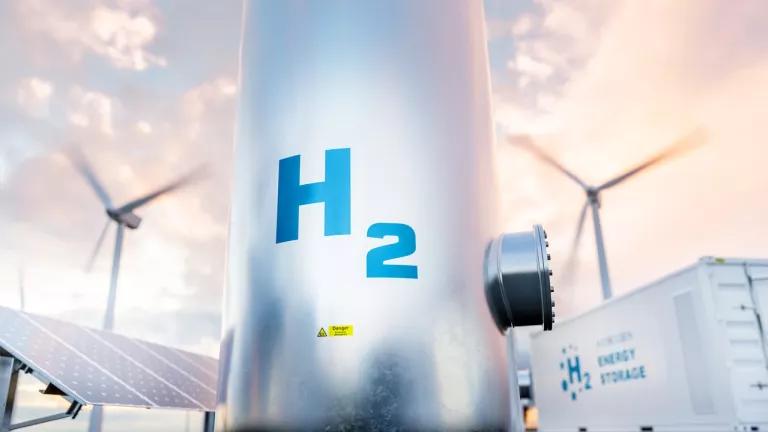Upping Key Tax Credit Can Help Cut U.S. Industrial Pollution
A new report from Rhodium Group shows how the American Jobs Plan can help the industrial sector cut pollution and create jobs.

A new report from Rhodium Group shows how the American Jobs Plan can help the industrial sector cut pollution and create jobs. The Rhodium report looked at one item in President Biden’s plan—the proposal to increase the tax credit for carbon capture and sequestration at industrial facilities like cement and steel plants. Rhodium evaluated a potential increase in the value of the tax credit to $85 per ton of industrial carbon pollution that’s captured and stored securely and long-term in geologic reservoirs (and not used for enhanced oil recovery), and assessed the impact on pollution and job creation. Their results are promising: raising the tax credit to this level would help jump-start the process of cutting industrial emissions and create tens of thousands of new jobs.
The Rhodium analysis compares the effect of the tax credit currently available to carbon capture projects (known as “45Q” for the name of its section under the tax code) with an enhanced credit for harder to decarbonize industrial sectors. The credit, currently worth $50 per ton of CO2 captured and stored, is not high enough to make such projects viable at industrial facilities that produce cement, iron and steel, among other industrial sub-sectors. However, when Rhodium modeled a higher tax credit value of $85 per ton of CO2 with secure geologic storage for these sectors, coupled with a proposal in Congress to extend the deadline for project starts until the end of 2030, they found that carbon capture projects to help decarbonize emissions-intensive industrial facilities become financially viable.
Rhodium’s analysis left current tax credit levels in place for sectors with lower-cost carbon capture, such as ammonia, ethanol and natural gas processing. For the harder-to-decarbonize sectors, Rhodium found the increase to $85 per ton of CO2 would result in deployment of carbon capture equipment capable of capturing and storing 212-252 million metric tons of carbon pollution from the industrial sector, including 49 million metric tons of capture capacity at cements plants and 14 million metric tons at iron and steel factories. More importantly, these projects will pave the way for broader and deeper pollution reductions. As the authors state, “Deployment in these sectors opens up meaningful opportunities for technology learning and cost reductions that could expand the reach of carbon capture to various other industrial applications over time.”

CCS is one of several key solutions to decarbonizing the industrial sector. In the cement industry, for example, most emissions are the unavoidable result of necessary chemical reactions associated with the cement manufacturing process. These emissions cannot be abated by relying on energy efficiency, electrification and/or fuel switching.
Importantly, while this was outside the scope of the analysis, the authors of the Rhodium analysis signal that installing carbon capture technology at industrial (and other) facilities is expected to also reduce conventional, non-CO2 pollutants. This is expected to occur because several types of conventional pollutants, like sulfur dioxide, must be removed from flue gases before carbon capture can occur. This is a critical area for further research, as the American Jobs Plan commits to making climate progress in the industrial sector while also protecting overburdened communities from increases in local pollution.
The Rhodium analysis demonstrates that increasing the 45Q tax credit for industrial capture can play a key role in advancing industrial carbon capture. It should be part of the package of measures needed to move the industrial sector forward. Included in that we also need to see:
- A tripling of research and development funding for industrial decarbonization;
- Robust support for multiple demonstration projects for new pollution reduction technologies;
- A strong federal buy-clean program such that all construction projects receiving federal funds should take climate pollution (and labor protection) into account when awarding contracts.
Separately, NRDC supports the near-term phase out of the credit available under 45Q for use of captured carbon in enhanced oil recovery.
President Biden pledged to halve U.S. climate emissions by 2030 and to do so while making historic investments to repair our crumbling infrastructure and put Americans back to work. The industrial sector accounts for roughly 25% of net emissions and includes some of the hardest to decarbonize segments of the economy, like cement manufacturing. Nevertheless, NRDC’s analysis finds that the United States can meet the President’s goal with a cut of roughly one-fifth (21%) in emissions from the industrial sector.
But beyond 2030, industries like cement will need to access a suite of advanced technologies to zero out their emissions. The important findings from Rhodium show that the right set of incentives as part of the American Jobs Plan can drive much-needed investment in these solutions now, even as we push ever harder to deploy the cheaper, readily available decarbonization solutions across the rest of our economy.



